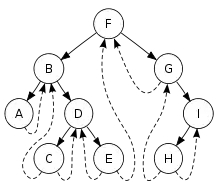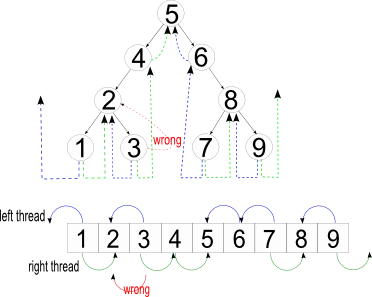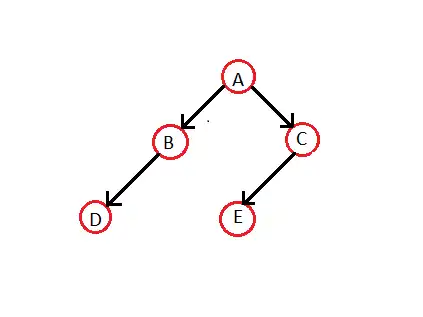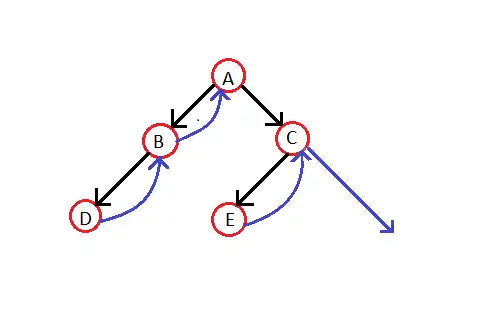Threaded binary tree
In computing, a threaded binary tree is a binary tree variant that facilitates traversal in a particular order (often the same order already defined for the tree).

An entire binary sort tree can be easily traversed in order of the main key, but given only a pointer to a node, finding the node which comes next may be slow or impossible. For example, leaf nodes by definition have no descendants, so no other node can be reached given only a pointer to a leaf node -- of course that includes the desired "next" node. A threaded tree adds extra information in some or all nodes, so the "next" node can be found quickly. It can also be traversed without recursion and the extra storage (proportional to the tree's depth) that requires.
Threading
"A binary tree is threaded by making all right child pointers that would normally be null point to the in-order successor of the node (if it exists), and all left child pointers that would normally be null point to the in-order predecessor of the node."[1]
This assumes the traversal order is the same as in-order traversal of the tree. However, pointers can instead (or in addition) be added to tree nodes, rather than replacing. Linked lists thus defined are also commonly called "threads", and can be used to enable traversal in any order(s) desired. For example, a tree whose nodes represent information about people might be sorted by name, but have extra threads allowing quick traversal in order of birth date, weight, or any other known characteristic.
Motivation
Trees, including (but not limited to) binary search trees, can be used to store items in a particular order, such as the value of some property stored in each node, often called a key. One useful operation on such a tree is traversal: visiting all the items in order of the key.
A simple recursive traversal algorithm that visits each node of a binary search tree is the following. Assume t is a pointer to a node, or nil. "Visiting" t can mean performing any action on the node t or its contents.
Algorithm traverse(t):
- Input: a pointer t to a node (or nil)
- If t = nil, return.
- Else:
- traverse(left-child(t))
- Visit t
- traverse(right-child(t))
One problem with this algorithm is that, because of its recursion, it uses stack space proportional to the height of a tree. If the tree is fairly balanced, this amounts to O(log n) space for a tree containing n elements. In the worst case, when the tree takes the form of a chain, the height of the tree is n so the algorithm takes O(n) space. A second problem is that all traversals must begin at the root when nodes have pointers only to their children. It is common to have a pointer to a particular node, but that is not sufficient to get back to the rest of the tree unless extra information is added, such as thread pointers.
In this approach, it may not be possible to tell whether the left and/or right pointers in a given node actually point to children, or are a consequence of threading. If the distinction is necessary, adding a single bit to each node is enough to record it.
In a 1968 textbook, Donald Knuth asked whether a non-recursive algorithm for in-order traversal exists, that uses no stack and leaves the tree unmodified.[2] One of the solutions to this problem is tree threading, presented by J. H. Morris in 1979.[3][4] In the 1969 follow-up edition,[5] Knuth attributed the threaded tree representation to Perlis and Thornton (1960).[6]
Relation to parent pointers
Another way to achieve similar goals is to include a pointer in every node, to that node's parent node. Given that, the "next" node can always be reached. "right" pointers are still null whenever there are no right children. To find the "next" node from a node whose right pointer is null, walk up through "parent" pointers until reaching a node whose right pointer is not null, and is not the child you just came up from. That node is the "next" node, and after it come its descendants on the right.
It is also possible to discover the parent of a node from a threaded binary tree, without explicit use of parent pointers or a stack, although it is slower. To see this, consider a node k with right child r. Then the left pointer of r must be either a child or a thread back to k. In the case that r has a left child, that left child must in turn have either a left child of its own or a thread back to k, and so on for all successive left children. So by following the chain of left pointers from r, we will eventually find a thread pointing back to k. The situation is symmetrically similar when q is the left child of p—we can follow q's right children to a thread pointing ahead to p.
Types
- Single Threaded: each node is threaded towards either the in-order predecessor or successor (left or right).
- Double threaded: each node is threaded towards both the in-order predecessor and successor (left and right).
In Python:
def parent(node):
if node is node.tree.root:
return None
else:
x = node
y = node
while True:
if is_thread(y):
p = y.right
if p is None or p.left is not node:
p = x
while not is_thread(p.left):
p = p.left
p = p.left
return p
elif is_thread(x):
p = x.left
if p is None or p.right is not node:
p = y
while not is_thread(p.right):
p = p.right
p = p.right
return p
x = x.left
y = y.right
The array of in-order traversal
Threads are reference to the predecessors and successors of the node according to an inorder traversal.
In-order traversal of the threaded tree is A,B,C,D,E,F,G,H,I, the predecessor of E is D, the successor of E is F.

Example

Let's make the Threaded Binary tree out of a normal binary tree:

The in-order traversal for the above tree is — D B A E C. So, the respective Threaded Binary tree will be --

Null links
In an m-way threaded binary tree with n nodes, there are n*m - (n-1) void links.
Iterative traversal
There is an algorithm for traversing a threaded binary tree without using recursion. Any such method must instead use iteration; that is, all steps must be done in a loop in order to visit all the nodes in the tree.
In-order traversal by definition first visits each node's left sub-tree (if it exists and if it is not already visited); then it visits the node itself, and finally the node's right sub-tree (if it exists). If the right sub-tree does not exist, but there is a threaded link, we make the threaded node the current node in consideration. An example is shown below.

Algorithm
- If the current node has a left child which is not in the visited list, then go to step 2, else step 3.
- Put that left child in the list of visited nodes and make it the current node. Go to step 6.
- Visit the node. If the node has a right child, then go to step 4, else go to step 5.
- Make the right child the current node. Go to step 6.
- If there is a thread node, then make it the current node.
- If all nodes have been printed then end, else go to step 1.
| Step | Li | ||
|---|---|---|---|
| 1 | 'A' has a left child B, which has not been visited. So, we put B in our list of visited nodes and B becomes our current node. | B | |
| 2 | 'B' has a left child, 'D', which is not in our list of visited nodes. So, we put 'D' in that list and make it our current node. | B D | |
| 3 | 'D' has no left child, so we visit 'D'. Then we check for its right child. 'D' has no right child and thus we check for its thread-link. It has a thread going till node 'B'. So, we make 'B' the current node. | B D | D |
| 4 | 'B' has a left child, but its already in the list of visited nodes. So, visit 'B'. Now check if it has a right child. It does not. So, make its threaded node (i.e. 'A') the current node. | B D | D B |
| 5 | 'A' has a left child, 'B', but it is already visited. So, visit 'A'. Now 'A' has a right child, 'C' and it is not visited. So add it to the list and make it the current node. | B D C | D B A |
| 6 | 'C' has an left child 'E' which is not visited. Add it to the list and make it the current node. | B D C E | D B A |
| 7 | and finally..... | D B A E C | |
References
- Van Wyk, Christopher J. Data Structures and C Programs, Addison-Wesley, 1988, p. 175. ISBN 978-0-201-16116-8.
- Knuth, D.E. (1968). Fundamental Algorithms. The Art of Computer Programming. 1 (1st ed.). Reading/MA: Addison Wesley.
- Morris, Joseph H. (1979). "Traversing binary trees simply and cheaply". Information Processing Letters. 9 (5). doi:10.1016/0020-0190(79)90068-1.
- Mateti, Prabhaker; Manghirmalani, Ravi (1988). "Morris' tree traversal algorithm reconsidered". Science of Computer Programming. 11: 29–43. doi:10.1016/0167-6423(88)90063-9.
- Knuth, D.E. (1969). Fundamental Algorithms. The Art of Computer Programming. 1 (2 ed.). Addison Wesley. Hre: Sect.2.3.1 "Traversing Binary Trees".
- Perlis, Alan Jay; Thornton, C. (Apr 1960). "Symbol manipulation by threaded lists". Communications of the ACM. 3 (4): 195–204. doi:10.1145/367177.367202.